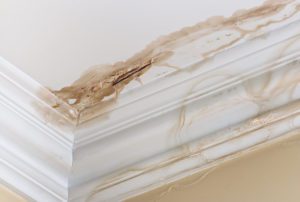- Normal aging
- Structural damage
Although buildings look stationary, they move to some extent because they’re built on top of soil that moves. As buildings age, they settle into the soil and this causes small cracks to appear here and there. These tiny cracks can easily be repaired and are nothing to worry about because they aren’t caused by problems with the foundation.
However, some cracks are a sign of serious structural damage. How do you know which is which? As you’ll see, the size and location of the crack(s) plays a role. If you see certain types of cracks, you should contact a foundation professional immediately.

Crack in the wall of a home
What Causes Cracks In Walls And Ceilings?
As we mentioned above, the normal settling that every structure experiences can cause hairline cracks to appear around windows and doors. Unless these cracks are wider than hairline width, they’re probably not something you should worry about. It’s always good to keep an eye on cracks though, just in case. If they get bigger, contact a foundation professional.
As the lumber used to build new homes dries out, it shrinks a little bit, and this can cause small cracks to appear in walls and ceilings. These are usually nothing to worry about.
Any home that’s sitting empty for most of the year – vacation homes, for example – will often develop cracks in walls and ceilings. This is because there’s no climate control for months at a time, and as the temperature and humidity inside the house go up and down, the materials used to build it can shrink and expand, causing cracks. This isn’t structural damage so you don’t need to worry too much about it. However, if you leave a home vacant for a long time, you should probably ask a foundation professional to conduct an inspection.

Improperly taped drywall can cause cracks in walls and ceilings. This can happen when the drywall installer doesn’t use enough drywall mud under the paper tape that covers the seams in the drywall sheets. Eventually, the tape starts to pull away from the drywall sheet and produces what looks like a crack.
When it comes to drywall, hairline cracks, are probably nothing to worry about. However, anything larger than a hairline crack could indicate structural movement.
Structural damage can also cause cracks in walls and ceilings. These cracks tend to be wide (over ¼ inch), long, jagged, or numerous (even if small). They are a sign that your home’s foundation has shifted significantly. There are many reasons for this including problems with expansive soil and poor construction. Contact a foundation professional immediately.
Ceiling cracks can also be caused by something heavy on the floor (or in the attic) above the ceiling. Bathrooms especially, are very heavy. If you see cracks along with sagging, contact a professional immediately.
Moisture on the floor above the ceiling can also cause cracking. The moisture might be coming from a plumbing leak, or from roof damage caused by a large storm with lots of wind and rain.

Peeling paint on an interior ceiling a result of water damage caused by a leaking pipe dripping down from upstairs a result of substandard plumbing completed by an unqualified plumber. A common house insurance claim.
Types Of Cracks In Walls And Ceilings
A crack that starts in the ceiling and runs down a wall is a clear sign of structural damage. Ditto for any crack that runs the entire length of a floor, ceiling, or wall. Contact a foundation professional right away for an inspection.
Ceiling cracks accompanied by sagging are another sign of structural damage. Actually, any crack accompanied by sagging or bowing – no matter where it is – needs to be looked at right away.
Spiderweb cracks – wherever their location – that radiate out from a point may just be the result of settlement. It really depends on the width of the crack. If they’re over 1/4 inch wide, they should be looked at.
Hairline cracks – including hairline spiderweb cracks – are usually caused by multiple layers of paint or problems with drywall mud.
As we pointed out above, hairline drywall cracks usually aren’t serious. However, drywall cracks larger than hairline width could indicate a foundation problem.
Generally, the location of a crack matters. For example, hairline cracks along the edge of a ceiling are probably due to normal settling. However, a crack across the middle of a ceiling – especially multiple cracks that are both long and wide – are a sure sign of a serious structural problem that needs immediate attention.
Also, if you see discoloration around a crack, that could indicate a plumbing leak. It might also indicate that water is getting in from somewhere, maybe from a window or the roof.
When You Should Worry
- If you see cracks that are larger than hairline width.
- If you see cracks that are long
- If you see diagonal cracks
- If you see many cracks, even small ones
- If you see cracks with discoloration around them. This is a sign of moisture getting in from somewhere.
- If you see one crack that goes across the ceiling and down a wall
- If you see a crack that goes all the way across a ceiling, wall, or floor.
If you see suspicious cracks in walls and/or ceilings, look for other signs of structural damage. For more information about what to look for, check out 11 Signs of Foundation Failure.
Remember, cracks in walls and ceilings are common and usually they’re just a cosmetic issue caused by normal foundation settling. However, sometimes they’re a sign of a serious structural problem. If you see a crack that looks suspicious, contact a foundation professional right away and ask for an inspection.


Hi, i git a crack in my ceiling after the neigbour was drilling into the party wall. 20 cm Block wall with Iron structure. He hang a heavy cupboard on the opposite side where i got the crack. The crack was first a haieline and now deepening and expanding. Could he hit the ironstructure which cause vibraciones and cracks? He has no experiencie in drilling. Might have used wrong tool. Also made a water leakage with his drilling/vibraciones